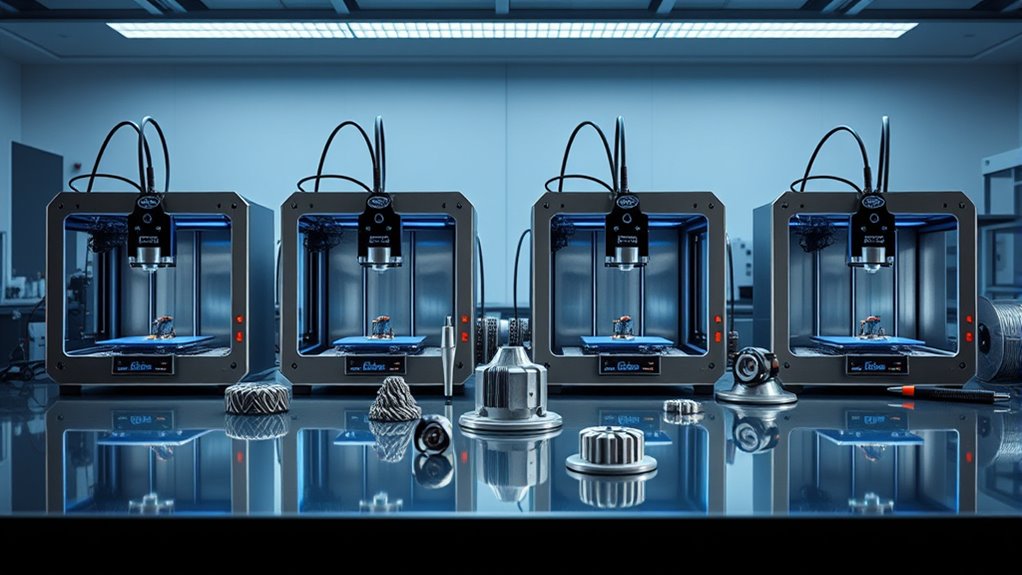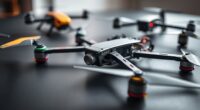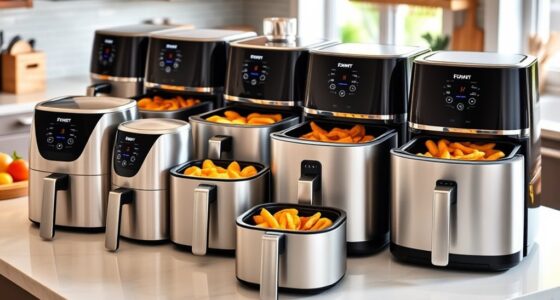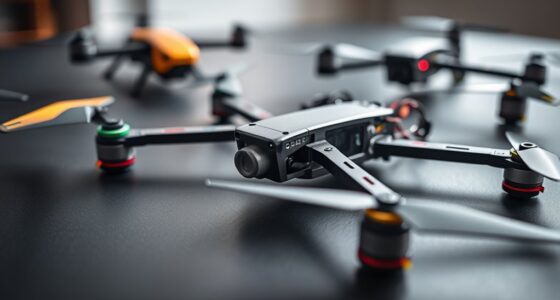If you’re exploring the best metal 3D printers for research in 2025, I recommend checking out options like the Top metal printers with high accuracy, large build volumes, and reliable software integrations. Machines such as the ones mentioned combine advanced materials compatibility, precise control, and ease of maintenance, making them ideal for cutting-edge research. Continue exploring to discover how these top picks can elevate your innovations and experiments.
Key Takeaways
- Top metal 3D printers in 2025 feature high-temperature capabilities and compatibility with advanced alloys like titanium and superalloys.
- Emphasis on precision with layer resolutions below 50 micrometers for detailed research applications.
- Advanced control over laser and electron beam parameters ensures consistent, accurate results.
- Integration of reliable software and post-processing options support complex research workflows.
- Machines offer large build volumes and multi-material options to facilitate innovative, large-scale research prototypes.
Original Prusa XL Assembled 3D Printer with 5 Toolheads
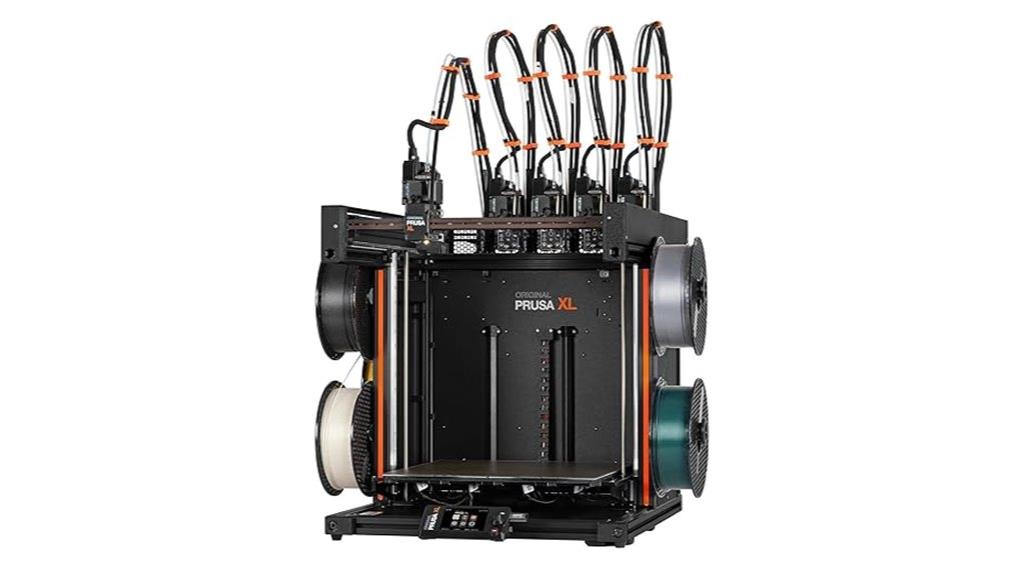
If you’re looking for a versatile and large-scale 3D printer for complex research projects, the Original Prusa XL with five toolheads is an excellent choice. It features a massive build volume of 14.17×14.17×14.17 inches, perfect for big, detailed models. The five independent toolheads enable multi-material, multi-color, and complex printing, reducing production time markedly. Its state-of-the-art CoreXY system ensures high precision and smooth motion. Designed for ease, it offers quick toolhead swapping, support for an enclosure, and network capabilities. Fully assembled and tested, it’s ready to handle demanding projects, making it ideal for professional and advanced hobbyist use.
Best For: professionals and advanced hobbyists seeking large-scale, multi-material, and complex 3D printing capabilities for detailed research projects and large models.
Pros:
- Large build volume of 14.17×14.17×14.17 inches for big, detailed prints
- Five independent toolheads enable simultaneous multi-material and multi-color printing, reducing production time
- Fully assembled, tested, and supported with lifetime technical assistance for reliable operation
Cons:
- High initial investment due to size and advanced features
- Some parts require assembly and careful handling during setup
- Size may limit portability and require ample space for operation
Original Prusa CORE One 3D Printer Kit

The Original Prusa CORE One 3D Printer Kit stands out as an ideal choice for beginners and hobbyists who want a reliable, high-quality machine that’s easy to assemble and operate. Its all-steel exoskeleton guarantees durability, while the CoreXY system delivers precise, high-speed printing. The enclosed chamber reaches 55°C, supporting a wide range of materials like PLA, PETG, ASA, PC, and Nylon. Features like automatic calibration, removable print sheets, and intuitive software make setup quick and straightforward. Plus, it includes a filament sample pack and offers lifetime support. Whether building your own or opting for a ready-to-use version, the CORE One emphasizes stability and long-term reliability.
Best For: hobbyists, beginners, and enthusiasts seeking a durable, high-quality 3D printer with easy assembly and versatile material compatibility.
Pros:
- All-steel exoskeleton frame ensures durability and long-term stability
- User-friendly features like automatic calibration and intuitive software simplify setup and operation
- Enclosed chamber supports a wide range of filament types, including demanding materials like Nylon and PC
Cons:
- DIY kit assembly may be challenging for complete beginners without prior experience
- Slightly larger footprint due to enclosed design may require more space
- Premium materials and features may come at a higher price point compared to basic models
Creality Ender 5 Max 3D Printer

Designed for researchers and advanced hobbyists, the Creality Ender 5 Max stands out with its massive 400×400×400mm build volume, enabling the creation of large prototypes or multiple small models in a single run. Its high-torque XY motor delivers speeds up to 700 mm/s with rapid acceleration, speeding up production. The reliable dual-gear direct drive extruder guarantees smooth extrusion and clog resistance, even in warmer environments. The sturdy frame and 36-point auto-leveling guarantee precise, stable prints. With a fast-heating 1000W bed reaching 80 °C in under 200 seconds, it supports a variety of filament types, making it versatile for research projects.
Best For: researchers and advanced hobbyists seeking large-scale 3D printing with high speed, precision, and versatility.
Pros:
- Massive 400×400×400mm build volume ideal for large prototypes and batch small models
- High-speed printing up to 700 mm/s with rapid acceleration enhances production efficiency
- Reliable dual-gear direct drive extruder ensures smooth, clog-resistant extrusion in warm environments
Cons:
- Large size may require significant space and sturdy setup area
- Complex features might have a steeper learning curve for beginners
- High power consumption due to the 1000W heated bed and rapid heating capabilities
Creality K1 SE 3D Printer
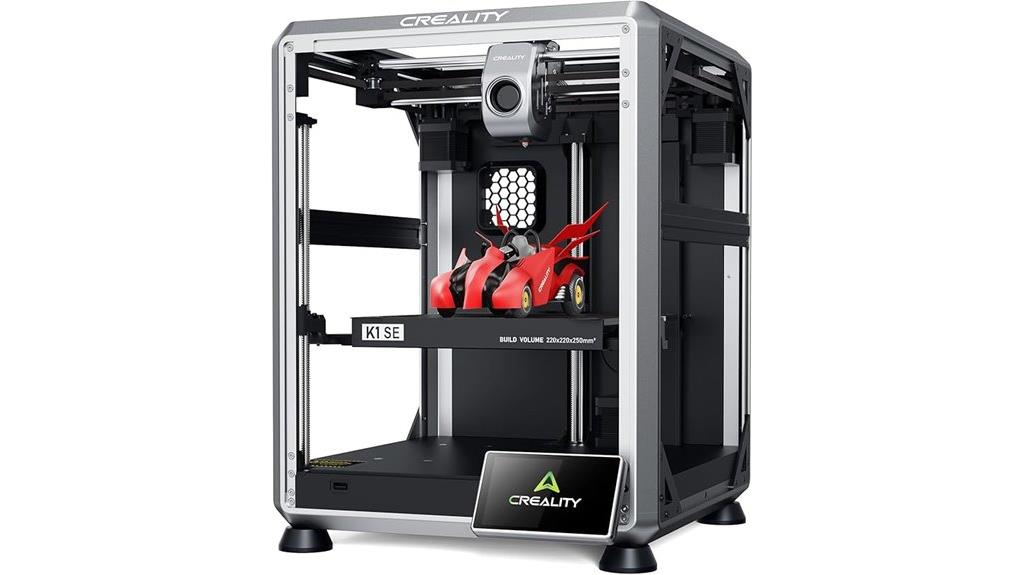
The Creality K1 SE 3D Printer stands out for its lightning-fast speed, making it an ideal choice for research teams that need rapid prototyping and high throughput. Its lightweight CoreXY system reaches speeds of up to 600mm/s and accelerates to 20,000mm/s², maintaining excellent print quality at such rapid rates. The reliable extruder and tri-metal nozzle handle flexible filaments like TPU and heat quickly from 0 to 300℃ in just 75 seconds. Its sturdy aluminum frame ensures stability during high-speed printing, while auto-calibration simplifies setup. With advanced cooling and open-source software, the K1 SE combines speed, precision, and ease of use for cutting-edge research applications.
Best For: researchers and prototyping teams seeking ultra-fast 3D printing with high precision and stability.
Pros:
- Achieves speeds up to 600mm/s with high acceleration, enabling rapid prototyping.
- Features a durable, rigid aluminum frame ensuring stability during high-speed operation.
- Open-source software with advanced features like linear advance and input shaping for enhanced print quality.
Cons:
- Relatively heavy at 22.5 pounds, which may affect portability.
- Larger footprint (13.9 x 13.9 x 18.9 inches), requiring ample space.
- New technology may require some user adaptation and calibration familiarity.
Creality K1C 3D Printer
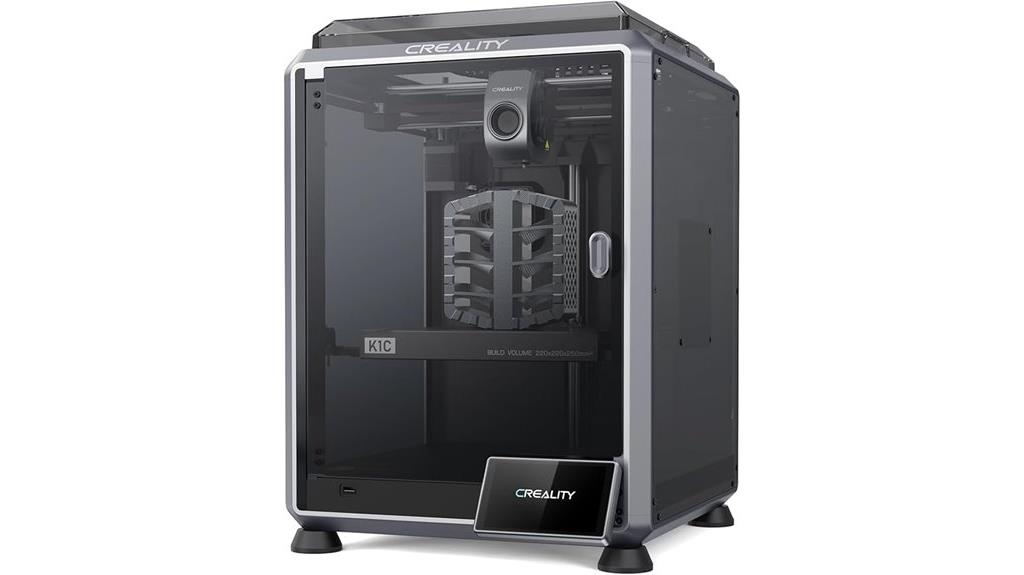
For researchers seeking rapid, high-quality metal 3D printing, the Creality K1C stands out with its high-speed CoreXY system and advanced features. It reaches speeds up to 600mm/s with an acceleration of 20,000mm/s², maintaining excellent print quality at these rapid rates. Its robust direct extruder and steel-tipped copper nozzle support high temperatures up to 300°C, enabling compatible printing with carbon fiber-reinforced filaments. Automated calibration, vibration reduction, and real-time AI monitoring ensure precise, reliable results. Plus, features like quiet operation, odor filtration, and a user-friendly interface make the K1C a versatile, efficient choice for demanding research projects.
Best For: researchers and professionals requiring rapid, high-precision metal 3D printing with reliable monitoring and advanced filament compatibility.
Pros:
- Exceptional high-speed printing capabilities up to 600mm/s with maintained quality
- Supports high-temperature printing up to 300°C, compatible with carbon fiber-reinforced filaments
- Automated calibration, vibration reduction, and AI-powered real-time monitoring enhance precision and ease of use
Cons:
- May have a higher initial cost due to advanced features and robust components
- The enclosed chamber and high-speed operation could generate noise despite silent mode options
- Requires proper handling and maintenance of high-temperature components to ensure longevity
FLASHFORGE Adventurer 5M 3D Printer with Auto Leveling
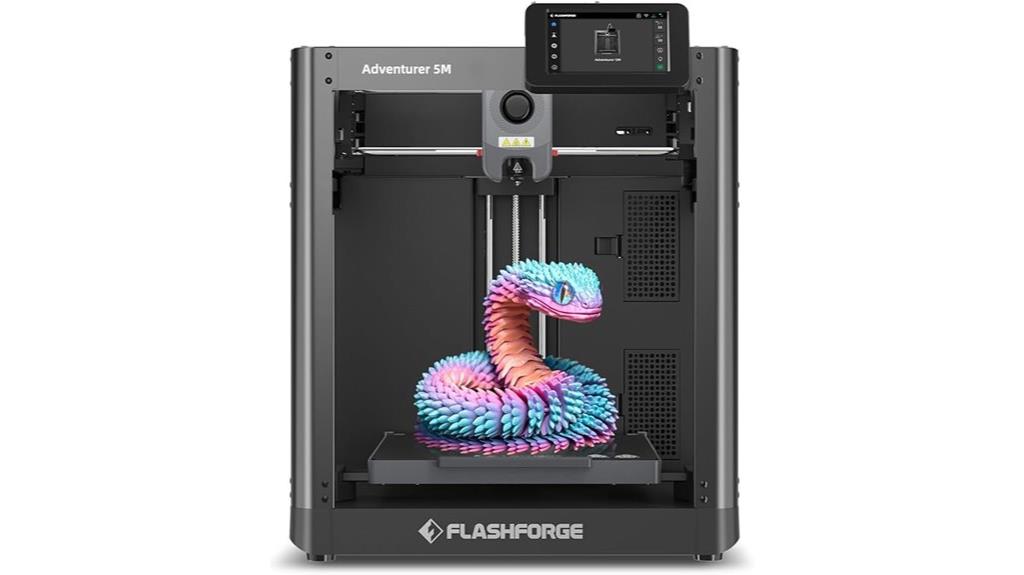
If you’re looking for a user-friendly 3D printer that combines high-speed performance with reliable auto bed leveling, the FlashForge Adventurer 5M is an excellent choice. It features a compact, enclosed design with a 220x220x220mm build volume, a CoreXY metal frame, and a fully automatic heated bed that self-levels in seconds. Its direct extruder reaches 280°C, supporting high-flow nozzles for fast, detailed prints. With speeds up to 600mm/s, vibration compensation, and an intuitive touchscreen, it’s perfect for rapid prototyping and educational use. Easy to set up, maintain, and upgrade, the Adventurer 5M delivers consistent quality with minimal effort.
Best For: hobbyists, educators, and beginners seeking a reliable, high-speed 3D printer with minimal setup and maintenance.
Pros:
- User-friendly with intuitive touchscreen interface and quick setup.
- High-speed printing capabilities (up to 600mm/s) with stable, high-quality output.
- Fully automatic bed leveling and magnetic heated bed for easy print removal and maintenance.
Cons:
- Limited build volume (220x220x220mm) may restrict larger projects.
- Included slicer software (FlashPrint) is basic; users often prefer third-party options for advanced control.
- Some users report filament feeding issues or nozzle clogging that may require troubleshooting.
FLASHFORGE AD5M 3D Printer with Auto Calibration and Quick-Swap Nozzle

With its auto-calibration feature and quick-swap nozzle system, the FLASHFORGE AD5M stands out as an ideal choice for researchers who prioritize efficiency and ease of use. Its fully automatic one-click leveling guarantees precise nozzle-to-build plate calibration, eliminating manual adjustments and ensuring flawless first layers. The flexible double-sided PEI steel plate simplifies model removal and supports PETG printing on the reverse side. Its robust CoreXY motion system enables high-speed printing up to 600mm/s without sacrificing quality, while the quick-release nozzle system allows swaps in just three seconds, accommodating various diameters for versatile, reliable, and maintenance-friendly operation.
Best For: researchers and professionals seeking a reliable, high-speed 3D printer with easy maintenance and versatile filament compatibility.
Pros:
- Fully automatic one-click leveling for precise calibration and flawless first layers
- Quick-release nozzle system allows swaps in just three seconds, supporting multiple diameters
- Supports high-speed printing up to 600mm/s with stable, smooth operation
Cons:
- The advanced features may require a learning curve for complete beginners
- Larger size and robust components could be more expensive compared to basic models
- Limited information on enclosed design or noise levels, which could impact use in noise-sensitive environments
FLASHFORGE AD5M 3D Printer with Auto Leveling and High-Speed Printing

The FLASHFORGE AD5M stands out for its remarkable high-speed printing capabilities, making it an excellent choice for researchers and professionals who need rapid prototyping and quick turnaround times. With speeds reaching up to 600mm/s and 20,000mm/s² acceleration, it markedly reduces print times without sacrificing quality. Its automatic bed leveling ensures reliable first-layer adhesion, while features like power loss recovery and filament runout detection enhance print reliability. The open-source design allows for customization, and remote control via the Flash Maker app streamlines workflow management. Overall, the AD5M combines speed, precision, and ease of use, making it a powerful tool for research environments.
Best For: professionals, researchers, and educators seeking fast, reliable 3D printing with customizable features and high-quality results.
Pros:
- Ultra-fast printing speeds up to 600mm/s for rapid prototyping and high-volume production
- Automatic bed leveling and advanced features like power loss recovery enhance print reliability
- Fully open-source firmware and hardware support customization and upgrades
Cons:
- Larger build volume may require more space in the workspace
- High-speed printing may necessitate higher-quality filaments and precise calibration
- Open-source design can require technical knowledge for modifications and troubleshooting
FLASHFORGE Adventurer 5M 3D Printer

Looking for a versatile 3D printer that balances ease of use with high-speed performance? The FlashForge Adventurer 5M is an excellent choice. It features automatic one-click leveling, a durable all-metal CoreXY structure supporting speeds up to 600mm/s, and quick-detachable nozzles for precision and efficiency. Its magnetic PEI steel build plate simplifies model removal, and the hotend swap system makes maintenance easy. While it supports materials like PLA, PETG, and ABS, high-speed printing can lead to print failures without proper bed adhesion. Overall, it’s a reliable, user-friendly machine suited for both beginners and experts, with some software limitations to contemplate.
Best For: hobbyists, educators, and professionals seeking a high-speed, versatile 3D printer with user-friendly features and reliable performance.
Pros:
- Automatic one-click leveling simplifies setup and calibration.
- Supports high-speed printing up to 600mm/s with stable, low-noise operation.
- Quick-detachable nozzles and magnetic PEI build plate enhance maintenance and model removal.
Cons:
- Software bugs and limited remote monitoring features can affect user experience.
- Print failures may occur at maximum speeds without proper bed adhesion or modifications.
- Firmware is locked down, limiting advanced customization and future upgrade options.
Official Creality Ender 3 3D Printer

If you’re starting out in 3D printing or teaching students, the Creality Ender 3 stands out thanks to its DIY assembly and open-source design, making it an accessible choice for beginners. It offers a build volume of 8.66×8.66×9.84 inches, perfect for small to medium projects. The printer features a resume function, so printing can resume after power outages. Its upgraded extruder reduces plugging issues, and the V-shape POM wheels ensure smooth, quiet operation. With minimal assembly—about two hours—it’s ideal for learning and experimentation, providing a reliable platform to develop core 3D printing skills.
Best For: beginners, students, and educators seeking an affordable, easy-to-assemble 3D printer to develop foundational skills and experiment with small to medium projects.
Pros:
- Fully open source design encourages customization and community support
- Resume printing function minimizes waste and time after power interruptions
- Easy assembly in about two hours makes it ideal for beginners and educational use
Cons:
- No phone connectivity support limits remote monitoring options
- Build volume is suitable for small to medium projects but not large-scale prints
- Requires verification of power supply voltage (115V) to ensure proper operation
Original Prusa XL Assembled 3D Printer with 2 Toolheads

For researchers seeking high-precision, multi-material 3D printing at a large scale, the Original Prusa XL assembled 3D printer with 2 toolheads stands out. It features a sizable build volume and up to five independent toolheads, enabling complex multi-color and multi-material projects. Its segmented heatbed, edge-to-edge accuracy, and advanced technologies like native Input Shaper and Pressure Advance ensure flawless prints. Quick tool swapping, reliable first layers, and network support make it user-friendly. The modular design, optional enclosure, and zero-waste capabilities make this printer ideal for professional research needs, delivering both versatility and precision in large-scale additive manufacturing.
Best For: researchers and professionals seeking high-precision, large-scale multi-material 3D printing with versatile and reliable features.
Pros:
- Supports up to five independent toolheads for complex multi-material and multi-color prints
- Large build volume (14.17×14.17×14.17 inches) ideal for sizable projects
- Advanced technologies like native Input Shaper and Pressure Advance ensure flawless, high-quality prints
Cons:
- Larger footprint may require significant space in the workspace
- Setup and calibration can be complex for users unfamiliar with advanced 3D printers
- Higher cost compared to smaller or single-material 3D printers
ANYCUBIC Photon Mono 4 Resin 3D Printer

The ANYCUBIC Photon Mono 4 Resin 3D Printer stands out for its ultra-high resolution, making it an excellent choice for researchers demanding detailed and precise models. Its 7.10K Mono LCD screen delivers a resolution of 9024×5120, with a pixel size of just 17×17μm, ensuring exceptional detail. The printer’s large build volume of 6.04 x 3.42 x 6.49 inches supports complex projects. Equipped with a stable LighTurbo light source and a laser-engraved print platform, it minimizes layer lines and warping. User-friendly features like a 4-point leveling system and resume printing make it accessible for both beginners and experts.
Best For: researchers and hobbyists seeking ultra-high resolution 3D printing with detailed and precise models.
Pros:
- Exceptional 7.10K resolution with 9024×5120 pixels for highly detailed prints
- Large build volume of 6.04 x 3.42 x 6.49 inches suitable for complex projects
- User-friendly features like 4-point leveling and resume printing for ease of use
Cons:
- Does not support Anycubic APP services, limiting remote management options
- Relatively lightweight at 7.7 pounds, which may affect stability during operation
- May be more expensive compared to lower-resolution or smaller-volume 3D printers
Original Prusa XL 3D Printer
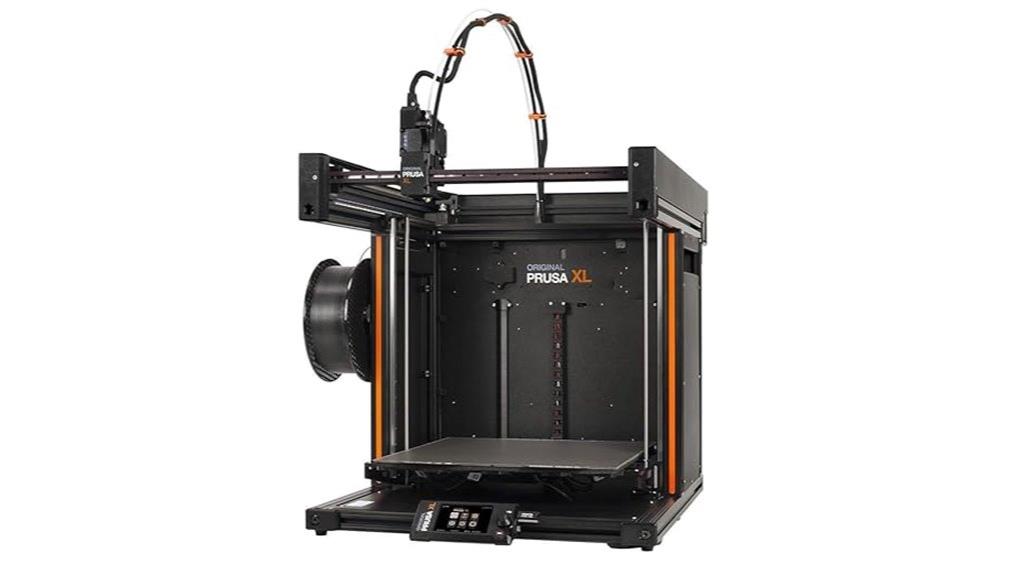
The Original Prusa XL 3D Printer stands out as an ideal choice for researchers and professionals demanding large-scale, multi-material printing with high precision. Its massive build volume of 14.17×14.17×14.17 inches supports complex projects and advanced material combinations, all while maintaining edge-to-edge accuracy. The five-toolhead system allows rapid switching between materials and colors, enhancing versatility. Equipped with a segmented heatbed, embedded 32-bit platform, and optional enclosure, it ensures reliable, high-quality prints. Its user-friendly design, network connectivity, and lifetime support make it perfect for demanding research environments. This printer truly elevates large-scale, multi-material 3D printing to a new standard.
Best For: researchers and professionals requiring large-scale, multi-material 3D printing with high precision and reliability.
Pros:
- Massive build volume of 14.17×14.17×14.17 inches ideal for complex and large projects
- Multi-material and multi-color capability with five-toolhead system for versatility
- Embedded 32-bit platform with advanced features like Input Shaper and Pressure Advance for high-quality, fast printing
Cons:
- Larger size may require more space and careful transportation setup
- Higher initial cost compared to smaller or single-material printers
- Complex assembly and maintenance might need a learning curve for new users
Creality K1 SE 3D Printer with Auto Leveling and Large Build Volume
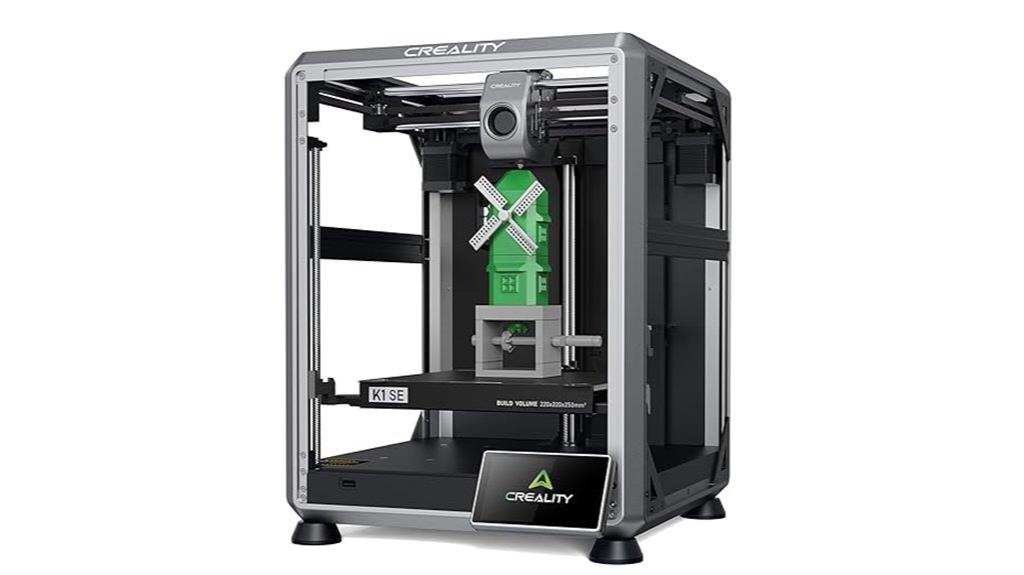
Creality K1 SE stands out as an excellent option for beginners and educational settings thanks to its auto-leveling feature and user-friendly design. It arrives fully assembled and pre-tuned, so you can set it up in just three minutes—no manual calibration required. Its large build volume and straightforward plug-and-play operation make it accessible for users of all skill levels. Plus, the Core XY structure delivers rapid, high-precision prints at speeds up to 600mm/s. With a durable nozzle, upgraded extruder supporting various filaments, and advanced stability features, the K1 SE ensures reliable, high-quality results, backed by excellent after-sales support.
Best For: beginners, kids, and educational environments seeking an easy-to-use, reliable 3D printer with fast setup and high-quality printing capabilities.
Pros:
- Fully assembled and pre-tuned for quick setup within three minutes
- Auto-leveling feature eliminates manual calibration, ideal for beginners
- High-speed Core XY structure achieves rapid, precise prints up to 600mm/s
Cons:
- Larger build volume may require more space and careful placement
- Advanced features and high speeds might require some learning curve for optimal use
- Premium components and support may come at a higher price point compared to basic models
Factors to Consider When Choosing Metal 3D Printers for Research

When selecting a metal 3D printer for research, I focus on key factors like material compatibility, printing accuracy, and build size to meet my project needs. Cost, maintenance, and how well the software integrates also influence my decision, ensuring long-term reliability. Understanding these points helps me choose a printer that balances performance and budget effectively.
Material Compatibility
Choosing the right metal 3D printer for research hinges on its material compatibility, as I need a system that can handle diverse alloys like stainless steel, titanium, aluminum, and superalloys. It’s essential that the printer supports various feedstock forms—powders, wires, or filaments—to suit different metals and research needs. High-temperature materials, such as superalloys, require printers capable of reaching and maintaining temperatures above 1000°C. Precise control over parameters like laser power or electron beam energy ensures consistent, accurate results. Additionally, compatibility with post-processing methods, such as heat treatments or surface finishing, is indispensable for optimizing material properties. Overall, a versatile, adaptable system allows for broad experimentation and innovation across multiple research projects.
Printing Precision
Achieving high printing precision in metal 3D printers is essential for producing detailed and accurate parts, especially in research settings. Fine layer resolutions, often below 50 micrometers, are key to capturing intricate features and ensuring dimensional accuracy. Advanced laser or electron beam melting technologies provide precise thermal control, promoting consistent layer bonding and minimizing errors. Reliable filament or powder feed mechanisms, including closed-loop systems, help maintain steady material flow, reducing deviations and improving print fidelity. Calibration features like automatic bed leveling and in-situ measurement tools are critical for maintaining accuracy during longer builds. Additionally, understanding material properties such as thermal expansion and flow behavior allows for better process control, ensuring complex geometries are produced with the desired precision. These factors collectively optimize the quality of research-grade metal 3D prints.
Build Volume
A larger build volume enables researchers to create more complex and sizable metal parts in a single print, which can streamline workflows and reduce assembly steps. This is especially important for experimental components that require precise control over dimensions, as the build size must match the scale of the research. However, bigger build areas often come with higher equipment costs and may demand more thorough safety and ventilation measures. The choice of build volume also influences the range of materials and geometries that can be produced, directly affecting research versatility. For high-precision work, it’s vital that the printer maintains dimensional accuracy throughout the entire build area. Ultimately, selecting the right build volume balances size needs with practical considerations to support your research objectives.
Cost and Maintenance
Metal 3D printers often come with hefty upfront costs, ranging from tens of thousands to over a hundred thousand dollars depending on their features. Beyond the initial purchase, maintenance expenses can add up quickly. Regular replacement of nozzles, filters, and laser components requires specialized parts that are costly and must be carefully managed. Operating costs are also high, mainly due to the need for high-quality metal powders, which must be replenished frequently. Additionally, these machines demand extensive calibration and routine system checks to maintain precision and safety, increasing ongoing maintenance efforts. Consumables and spare parts greatly influence the total cost of ownership over the printer’s lifespan. When choosing a metal 3D printer for research, it’s essential to factor in these ongoing costs alongside initial investment to guarantee sustainable operation.
Software Integration
Choosing a metal 3D printer for research hinges on effective software integration, which guarantees smooth communication between the machine and your design tools. Seamless file transfer and compatible workflows with industry-standard formats like STL, STEP, and AMF are critical for efficient project progress. Advanced software features such as real-time monitoring, auto-calibration, and precise parameter control enhance accuracy and minimize manual adjustments during printing. Support for open-source firmware and customizable APIs empowers researchers to adapt software to specific experimental needs and automate complex sequences. Additionally, robust software ecosystems often include safety features, error detection, and alert systems, helping prevent print failures and ensuring consistent, reliable results. Prioritizing software integration streamlines your research process and maximizes the capabilities of your metal 3D printer.
Safety Standards
Ensuring safety standards are met is essential when selecting metal 3D printers for research, as compliance with industry regulations helps protect users and maintain a secure lab environment. I look for printers that adhere to OSHA, CE, and UL standards to guarantee safe operation. Proper ventilation and fume extraction systems are critical because metal printing releases hazardous particles and gases, so I prioritize machines with built-in or compatible safety features. Safety interlocks and emergency shutdowns are vital for preventing accidents, especially around high temperatures and moving parts. Electrical safety measures like grounding and circuit protection are also non-negotiable to avoid electrical hazards. Choosing printers with certified safety protocols minimizes risks of fire, chemical exposure, and mechanical injuries, ensuring a safe and compliant research environment.
Frequently Asked Questions
How Do Metal 3D Printers Ensure Safety During High-Temperature Operations?
Metal 3D printers guarantee safety during high-temperature operations by incorporating advanced ventilation and filtration systems that capture harmful fumes and particles. I also rely on built-in thermal sensors and automated shut-off features that trigger if temperatures become unsafe. Additionally, using protective enclosures and following strict operational protocols helps prevent accidents. These measures give me confidence that high-temperature printing is both precise and safe.
What Are the Maintenance Requirements for High-Precision Metal 3D Printers?
Maintenance for high-precision metal 3D printers involves regular cleaning of the build chamber, nozzles, and filters to prevent material buildup. I also check and calibrate the laser or electron beam alignment periodically to guarantee accuracy. Lubricating moving parts and inspecting for wear helps avoid malfunctions. Additionally, updating software and firmware keeps the system running smoothly, ensuring consistent high-quality prints and extending the machine’s lifespan.
How Do Different Metal Alloys Impact Print Quality and Durability?
Different metal alloys dramatically impact print quality and durability, often in ways that seem almost magical. For example, titanium offers exceptional strength and corrosion resistance, making it perfect for aerospace, whereas stainless steel provides a balance of toughness and affordability. Aluminum keeps things lightweight but still strong, ideal for automotive parts. Choosing the right alloy means revealing superior precision, durability, and performance, transforming your projects into engineering marvels.
What Software Compatibility Considerations Are Essential for Research Applications?
When selecting software for research, I focus on compatibility with the printer’s firmware and CAD programs I already use. It’s essential that the software supports complex geometries and offers precise control over print parameters. I also look for open-source options or APIs that allow customization, making sure I can tailor the software to specific research needs. Seamless integration ensures efficient workflows and high-quality, reproducible results.
How Scalable Are Metal 3D Printers for Large-Volume Research Projects?
Metal 3D printers can be quite scalable for large-volume research projects, especially those designed with modular or multi-laser systems. I’ve found that while some models handle increased volume well, others may face limitations due to build size or processing speed. It’s essential to evaluate your project’s scale and choose a printer that offers flexibility, durability, and efficient throughput without compromising precision or quality.
Conclusion
Choosing the right metal 3D printer feels like opening a new realm of innovation, where precision sparks to life like a blazing forge and every layer builds a future. Whether you’re crafting intricate prototypes or pushing research boundaries, these top picks ignite your passion for discovery. Imagine the thrill of turning raw metal into masterpieces, each print a testament to your vision. Embrace these machines — your gateway to shaping tomorrow’s breakthroughs.
